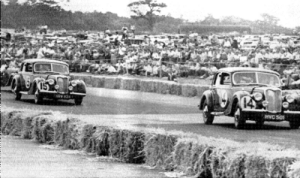
The RM Series Rileys

RMs Racing at Silverstone 1949
To put the RM Series Rileys into perspective it is necessary to look at the origins of the Company. The Riley family was founded in the Coventry weaving industry and as this industry declined diversification was clearly needed. The initial move was into supporting weaving equipment followed by a move into bicycles. At about the same time the younger members of the Riley family took an interest in the newly invented motor car.
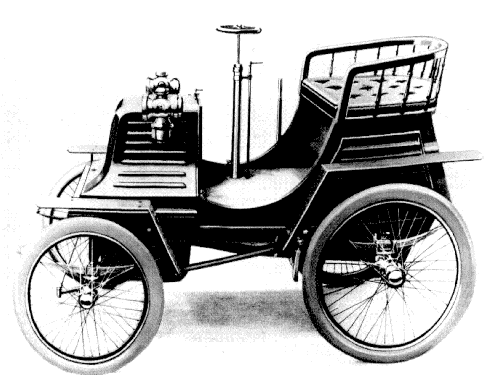 Percy Riley was a very good engineer and he completed his first car in 1899 and
exhibited it at the Dublin Show. For its time the design was quite advanced
having a steering wheel instead of the more usual tiller but its most important
feature related to the inlet valve. In all previous engines the inlet valve had
been closed by cylinder pressure but in Percy’s engine the valve was
mechanically controlled. A few years later this saved the British motor
industry when a German company tried to patent it and effectively take over the
motor industry world wide.
Percy Riley was a very good engineer and he completed his first car in 1899 and
exhibited it at the Dublin Show. For its time the design was quite advanced
having a steering wheel instead of the more usual tiller but its most important
feature related to the inlet valve. In all previous engines the inlet valve had
been closed by cylinder pressure but in Percy’s engine the valve was
mechanically controlled. A few years later this saved the British motor
industry when a German company tried to patent it and effectively take over the
motor industry world wide.
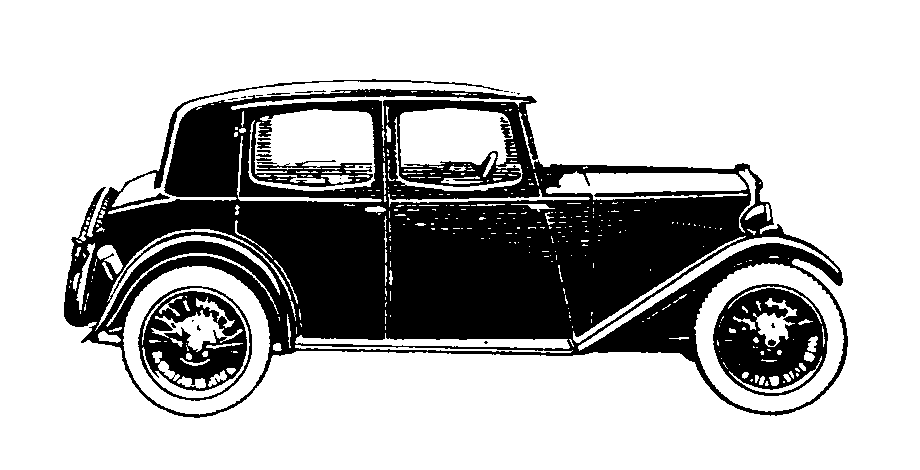 During the first quarter of the new century Riley
produced high quality if somewhat uninspiring cars. All this changed in 1926
when the Company introduced Percy’s latest design, the Riley Nine. The Monaco
was a full four seater saloon with a light weight fabric body and a fully
enclosed boot. In common with its Tourer equivalent it had a sturdy but light
chassis and, best of all, the new Riley Nine Engine. The specification of this
engine was closer to a racing car of the day than a family saloon. It had twin
camshafts, hemispherical combustion chambers with a central spark plug and gas
cross flow. These cars were just asking to be stripped down and put on a race
track. The Factory soon produced its own racing car, the Brooklands Nine and it
was not long before the engine grew two more cylinders and became the Brooklands
Six. Depending on the piston size the Six engine was sold in 12, 14 or 15 HP
versions. In 1935 a 1½ litre engine was introduced being a bigger version of
the Nine engine with the addition of a central crankshaft bearing. A couple of
years later an even bigger four cylinder 2½ litre engine was introduced.
Carried away by its technical success the factory produced far too many
different types of body and chassis during the 1930’s and financial failure
followed.
During the first quarter of the new century Riley
produced high quality if somewhat uninspiring cars. All this changed in 1926
when the Company introduced Percy’s latest design, the Riley Nine. The Monaco
was a full four seater saloon with a light weight fabric body and a fully
enclosed boot. In common with its Tourer equivalent it had a sturdy but light
chassis and, best of all, the new Riley Nine Engine. The specification of this
engine was closer to a racing car of the day than a family saloon. It had twin
camshafts, hemispherical combustion chambers with a central spark plug and gas
cross flow. These cars were just asking to be stripped down and put on a race
track. The Factory soon produced its own racing car, the Brooklands Nine and it
was not long before the engine grew two more cylinders and became the Brooklands
Six. Depending on the piston size the Six engine was sold in 12, 14 or 15 HP
versions. In 1935 a 1½ litre engine was introduced being a bigger version of
the Nine engine with the addition of a central crankshaft bearing. A couple of
years later an even bigger four cylinder 2½ litre engine was introduced.
Carried away by its technical success the factory produced far too many
different types of body and chassis during the 1930’s and financial failure
followed.
1937 was a very bad trading year and a new policy for model production was needed which would be introduced for the 1939 season. It was decided to produce just two engine types, a revised 1½ litre and a 2½ litre. To complement these there would be two body styles, Saloon and Drophead. These changes came too late and before the 1939 trading season had properly started Riley was in Receivership and was sold to Lord Nuffield. All the body jigs for the 1939 cars were destroyed during the WW2 raids on Coventry so a new body was introduced when manufacture recommenced in 1945.
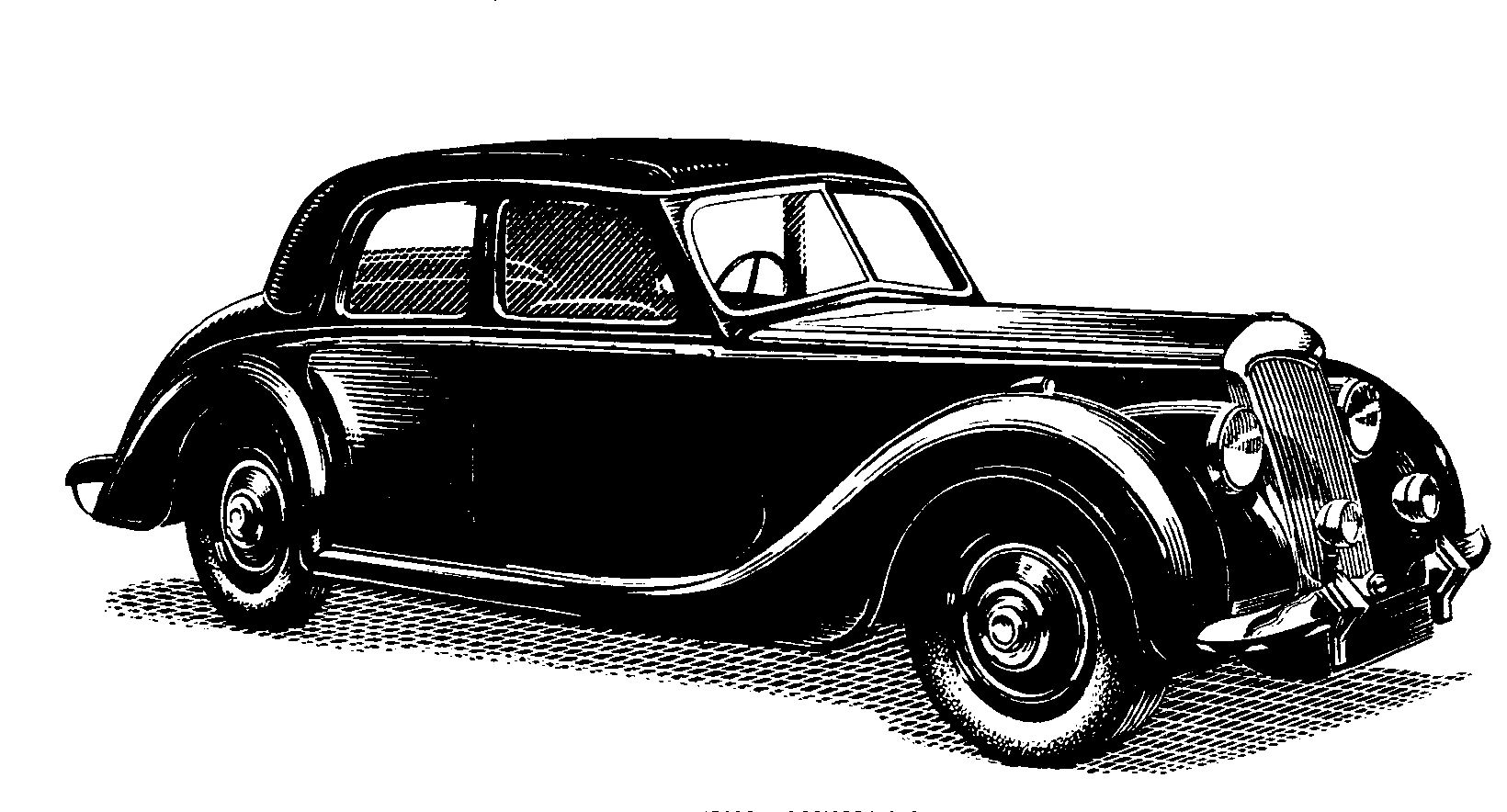 The policy of keeping to two engine sizes
remained post war and the first model to be introduced was called the RMA. It
was a four/five seater saloon with the 1½ litre engine. This was quickly
followed by the RMB which had basically the same body but on a longer heavier
chassis powered by the 2½ litre engine. A couple of years later the American
export market looked attractive and an open 3 seater Roadster based on the 2½
litre chassis was produced known as the RMC as well as a 4 seater Drophead known
as the RMD. The saloon models continued with only minor changes until 1952 when
a revised chassis was introduced for the 1½ litre car which was given the tally
RME. Initially this chassis carried the old RMA body but this was given a
complete face lift for 1954 by introducing knife edge bodywork and spats over
the rear wheel. The 2½ litre chassis was also revised in 1952 to become the RMF
although the body work was largely unchanged with alterations being confined to
the bumpers, rear window and roof height. 1955 was the last year of production
for the classic RM body style but it was not the end of the RM Series. The last
RM was the RMH or the Pathfinder. Although this retained an engine similar to
the RMF’s the body and chassis were totally new being based on a rounded three
box profile.
The policy of keeping to two engine sizes
remained post war and the first model to be introduced was called the RMA. It
was a four/five seater saloon with the 1½ litre engine. This was quickly
followed by the RMB which had basically the same body but on a longer heavier
chassis powered by the 2½ litre engine. A couple of years later the American
export market looked attractive and an open 3 seater Roadster based on the 2½
litre chassis was produced known as the RMC as well as a 4 seater Drophead known
as the RMD. The saloon models continued with only minor changes until 1952 when
a revised chassis was introduced for the 1½ litre car which was given the tally
RME. Initially this chassis carried the old RMA body but this was given a
complete face lift for 1954 by introducing knife edge bodywork and spats over
the rear wheel. The 2½ litre chassis was also revised in 1952 to become the RMF
although the body work was largely unchanged with alterations being confined to
the bumpers, rear window and roof height. 1955 was the last year of production
for the classic RM body style but it was not the end of the RM Series. The last
RM was the RMH or the Pathfinder. Although this retained an engine similar to
the RMF’s the body and chassis were totally new being based on a rounded three
box profile.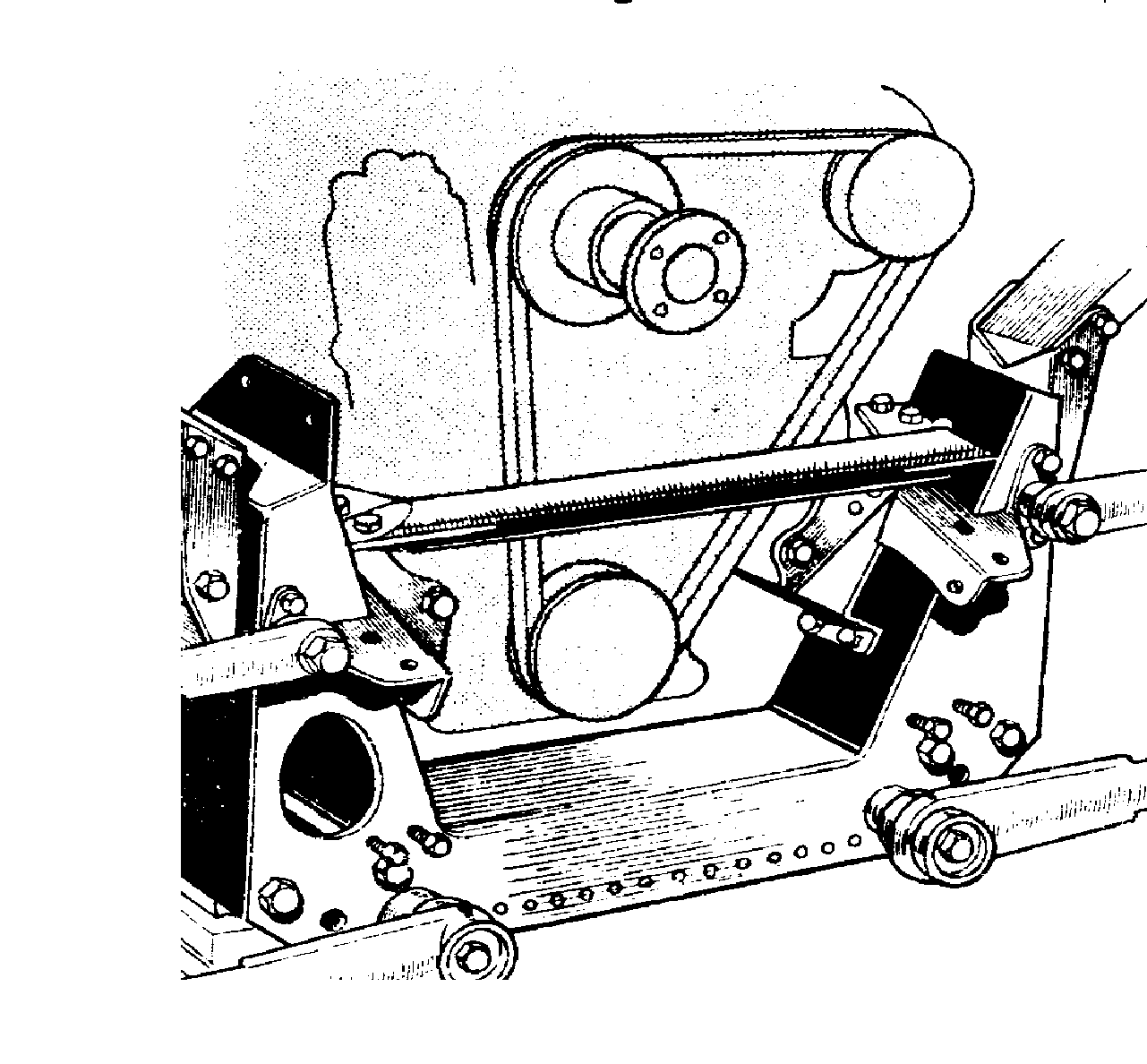
Since the RMA set the pattern for the later cars it is worth looking at this in some detail. Before the war Rileys had been examining the front suspension used on the Citreon and were clearly very impressed by it. As a result the post war Riley front suspension and steering have more than a passing resemblance to the Citreon set up introduced over a decade earlier. The chassis was made from two 1/8" thick U-channels, one channel being slipped inside the other to form a box with the top and bottom section 1/4" thick. These were then welded along their full length and joined by 5 very substantial tubular cross members. The rear of the chassis was swept up and over the rear axle to accommodate semi elliptical springs with 10 leaves per spring.
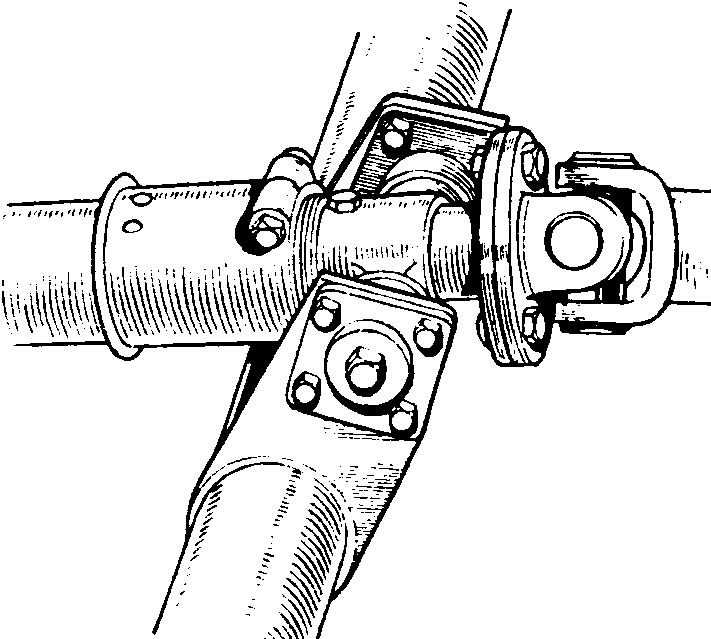 The rear axle was a spiral bevel with the prop. shaft
enclosed in a torque tube. The front of the torque tube followed 1939 practice
and was attached to a cross member from where a short open prop. shaft connected
it to the gear box. This gave the rear axle very precise location coupled with
easy removal of the gearbox.
The rear axle was a spiral bevel with the prop. shaft
enclosed in a torque tube. The front of the torque tube followed 1939 practice
and was attached to a cross member from where a short open prop. shaft connected
it to the gear box. This gave the rear axle very precise location coupled with
easy removal of the gearbox. 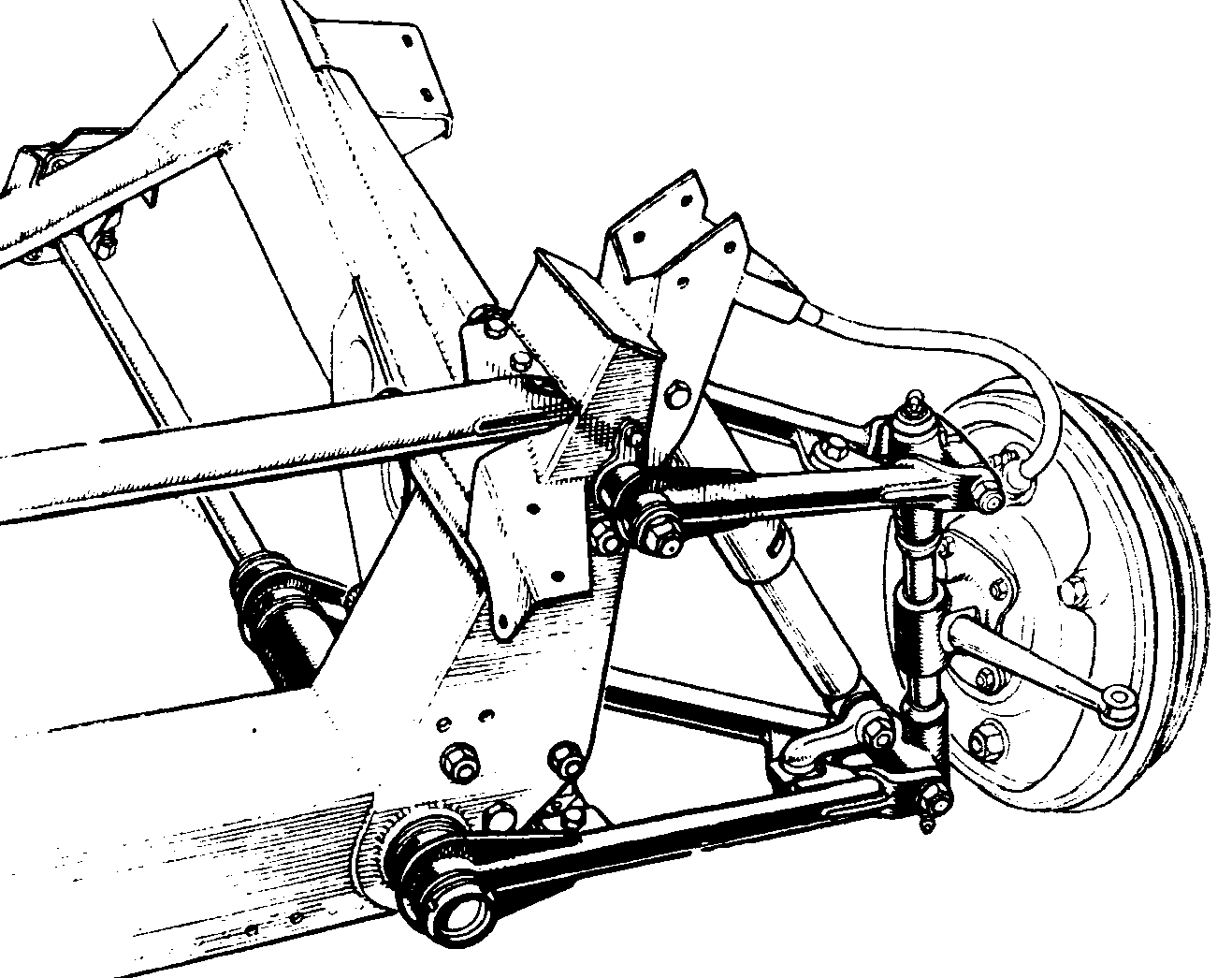 The front of the chassis side members ended in
vertical plates to which was bolted a heavily boxed U-cradle which carried the
front suspension . The U-cradle had a removable tubular cross member which
greatly eased engine removal. Steering was by rack and pinion (2½ turns lock to
lock) which was bolted to the U-cradle along with a forward chassis extension to
carry the radiator and the front jacking points. The whole front end was so
stiff that it was not necessary to allow for any toe in. The gearbox and clutch
were identical to the 1939 ones being a conventional four-on-the-floor box with
reverse coupled to a Borg and Beck single plate clutch. Synchromesh was fitted
to 2nd., 3rd., and top gears but with a heavy flywheel a somewhat leisurely
change was needed.
The front of the chassis side members ended in
vertical plates to which was bolted a heavily boxed U-cradle which carried the
front suspension . The U-cradle had a removable tubular cross member which
greatly eased engine removal. Steering was by rack and pinion (2½ turns lock to
lock) which was bolted to the U-cradle along with a forward chassis extension to
carry the radiator and the front jacking points. The whole front end was so
stiff that it was not necessary to allow for any toe in. The gearbox and clutch
were identical to the 1939 ones being a conventional four-on-the-floor box with
reverse coupled to a Borg and Beck single plate clutch. Synchromesh was fitted
to 2nd., 3rd., and top gears but with a heavy flywheel a somewhat leisurely
change was needed.
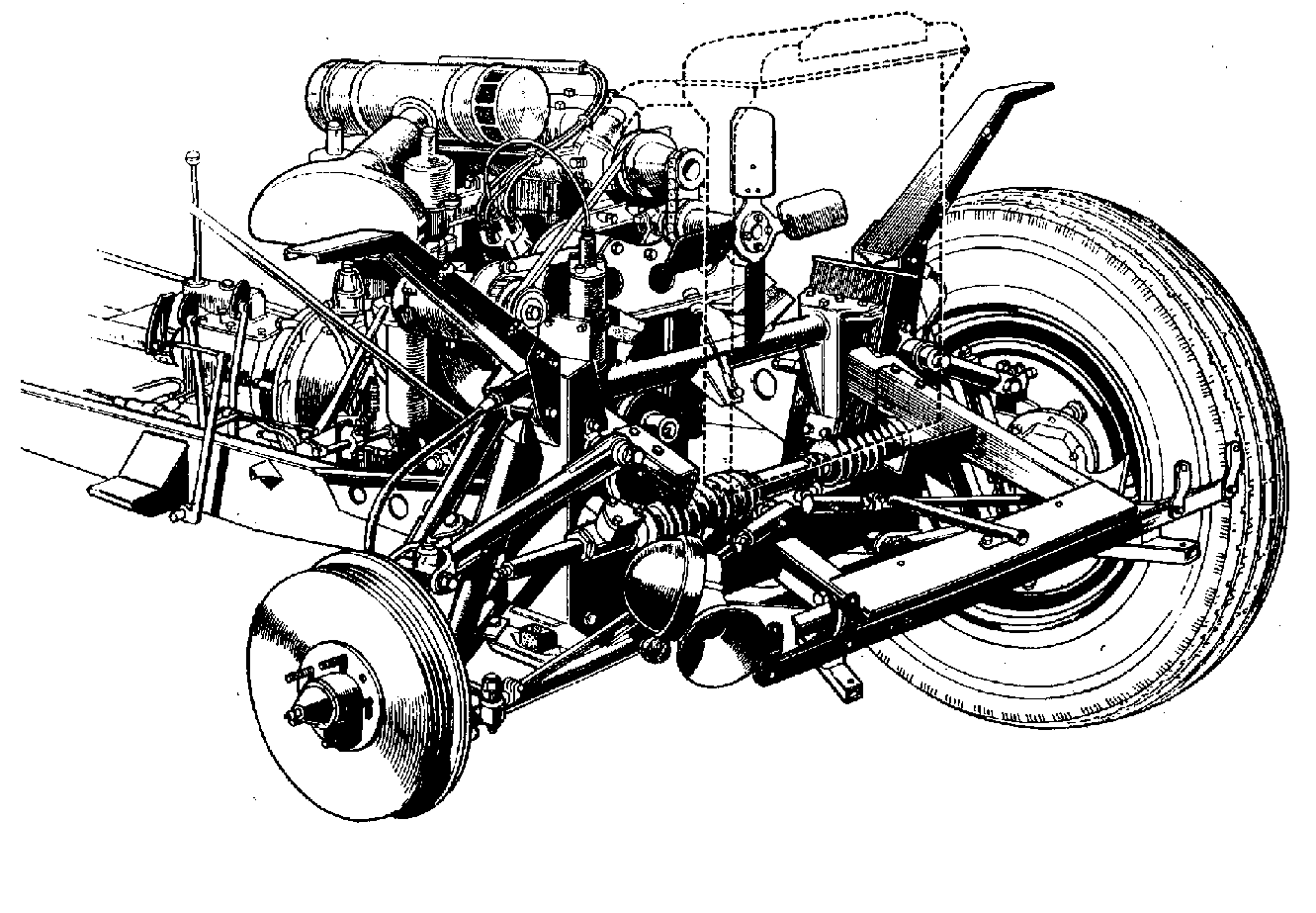
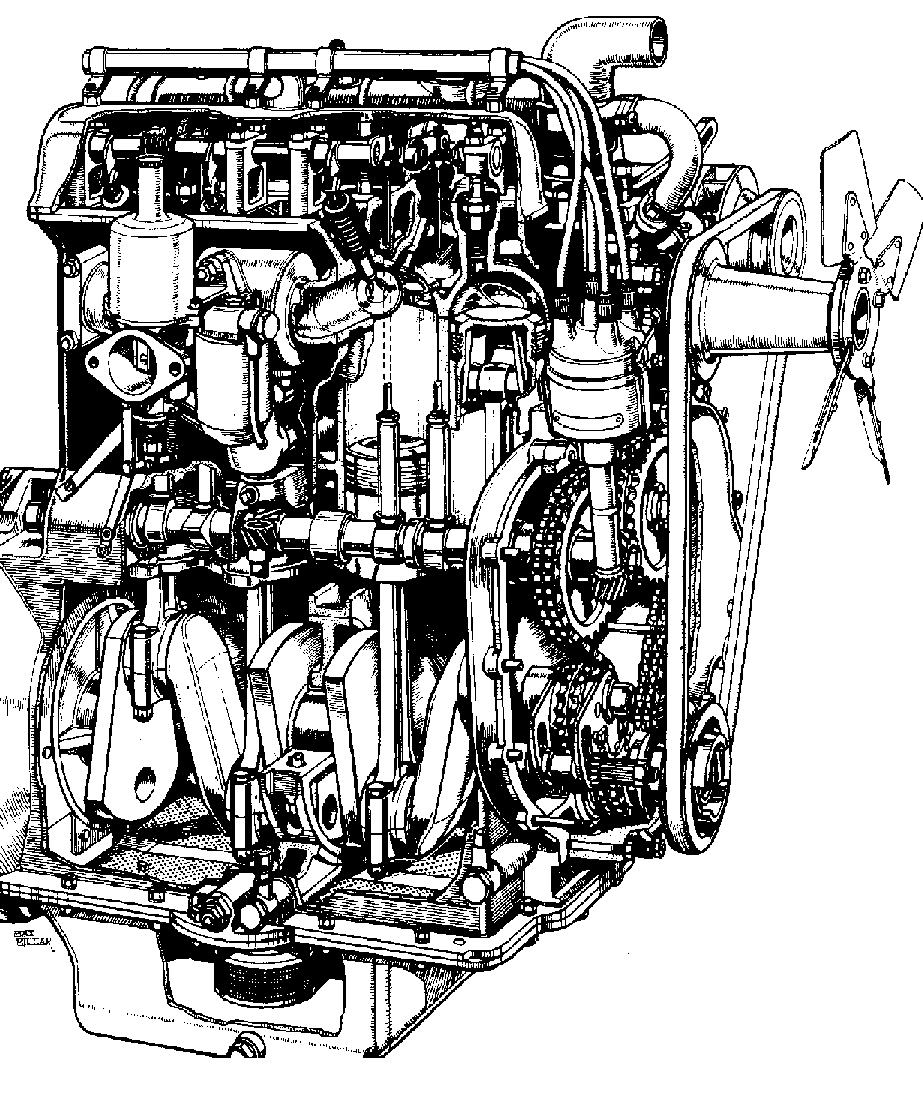
The engine of 1496 cc. capacity was almost identical to the 1939 unit lacking only the gear drive to the camshafts, this having been replaced by a conventional Renolds chain drive . The crankshaft was a single piece forging supported by three main bearings of generous sizes pressure fed by oil from a gear pump in the sump. The cylinder block was a one piece casting with strong cross webs to support the main bearings. The main bearings themselves had to be fitted to the crank shaft and then the whole assembly was threaded into the cylinder block from the rear and bolted in place. This provided a very rigid structure. The general layout had changed very little from the Riley Nine engine of 1926 as can be seen by the head on comparison over leaf. The earlier engine is on the left hand side
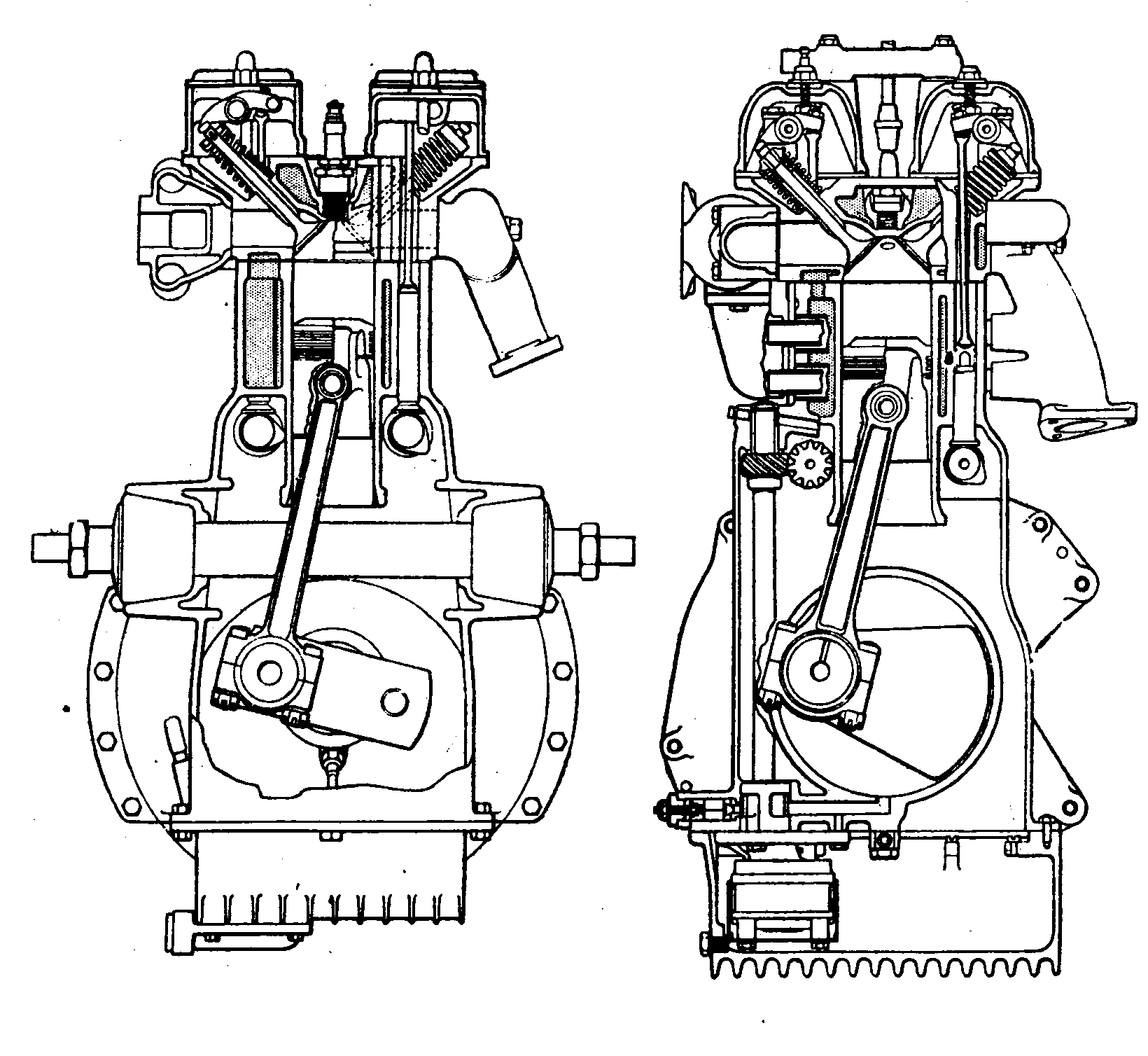
The body had long sweeping lines with room for 5 people on leather covered seats surrounded by wood trim. The seats were very comfortable with arm rests and even a platform on which the driver could rest his/her left foot away from the clutch pedal. The body was semi-coach built with the passenger compartment being ash framed covered in steel. The roof was of perforated steel covered in padding topped off with Everflex leather cloth. The boot compartment was a steel fabrication with wood only being used in the number plate panel. The bonnet tops and engine compartment side panel were usually made of aluminium although steel ones were not uncommon.
The RMB was very similar to the RMA in general construction but had a lengthened and beefed up chassis to carry the heavy 2½ litre engine. Again this had changed little from the prewar unit retaining the long 120 mm. stroke and the capacity of 2443 cc. Brakes and suspension were uprated to match the greater weight and performance.
When first introduced both models scored an immediate hit both with the Motoring Press and the few who were able to buy them. All cars were in short supply in the 1940’s and early 1950’s and Rileys were quite expensive too. In 1946 the RMA (with purchase tax) cost £710 while the RMB cost £1,125. The first thing to strike most owners was the overall shape which was so much more elegant than the prewar style. The next thing to attract attention was the way they handled. The new front suspension worked just as well on the Riley as it had on the Citreon. The road holding too was safe and predictable. The 1½ litre car handled particularly well although it felt under powered compared to its bigger brother. The 2½ litre had the torque and power to give real enjoyment to driving (petrol permitting). It was a bit front end heavy but with so much torque sitting under the right foot it was easy to bring the rear end out a bit and line everything up properly. With a top speed comfortably in excess of 90 mph. the 2½ litre was a real driver’s car.
Today these cars are still fun to drive especially with radial tyres fitted. The 2½ litre car makes an ideal long distance tourer or towing car although the cars produced up to 1952 can break half shafts. These always break at the inboard splined end just where the splines start. Some car/driver combinations seem more prone to half shaft failures than others. The writer drove his RMB hard for many years without breaking anything. In 1952 a hypoid rear axle coupled to an open prop. shaft was introduced. The half shafts in these do not seem to fail at all. They are thinner than the earlier ones allowing them to wind up a little to absorb shock but even more importantly that have two extra splines thus spreading the load over a greater area. The 1½ litre car was also given a similar axle at the same time. In parallel with the axle changes, both cars were given full hydraulic brakes in place of the hydro-mechanical systems used previously. The later brakes are generally easier to maintain but in the case of the 2½ litre car the stopping power is unchanged. The stopping power of the 1½ car was improved not by the introduction of the full hydraulic system but by the introduction of twin leading shoes at the front in place of the earlier leading/trailing system.
Over the years many people have suffered failure of the big end bearings. Apart from the last few 2½ litre cars, all RMs have white metal cast direct onto the rods. Although it is possible to modify the con. rods to take shell bearings this is not where the problem lies. The problem lies in the oil ways in the crank shaft. The RM engines are derived directly from the Riley Nine engine of 1926 and that engine did not have an oil filter. Instead it used sludge traps and these were cleaned out each time the engine was overhauled. In 1926 engines were overhauled very frequently so the sludge traps were always being cleaned out. The RM engines were fitted with oil filters but retained the sludge traps. Unfortunately neither the RM Driver’s Handbook nor the Workshop Manual mention these and after many miles they become completely blocked. This results in an excellent oil pressure but no oil flow. Cleaning the sludge traps in the big end oil ways involves removing hexagon socket plugs which are usually well stuck. More often than not the hexagons round off and the plugs have to be drilled out. This cannot be done in situ and the engine has to come out and be completely stripped. Human nature dictates that most people refuse to recognise the problem until the big ends fail so beware of any car with a hot tick over oil pressure above 10 to 15 psi. unless the engine is known to be almost new. It is possible to prevent future problems by drilling additional oil ways to circumvent the sludge traps.
Keeping these cars on the road does not present too many problems. There are two specialist clubs, the Riley Motor Club and Riley RM Club, who can provide both spares and technical advice, as well as a number of traders. The Riley Motor Club has the distinction of being the second oldest one make car club in the world having been founded in 1925 so, not surprisingly, it has a considerable amount of archive material.
Mechanically these cars are very tough and spares are plentiful with many parts being common to other marques of the period. Body parts are becoming easier to find too as more people produce specialist items such a new body timbers. The result is that these cars are now becoming much easier to restore and more rebuilt cars are coming onto the roads every year. Despite a total production of less than 30,000, these car are a common sight at rallies. They do not appear often in the "for sale" columns as ownership tends to be a life long disease hence when they do appear the price tag is generally quite high. Basket cases can still be bought quite cheaply but the work involved in the complete restoration of a large coach built car should not be under estimated. Despite all the work involved, undertaking a complete restoration is very satisfying which probably explains why so few cars are offered for sale.
The catch phrase coined by Rileys for the RM series was "Magnificent Motoring" - how true.
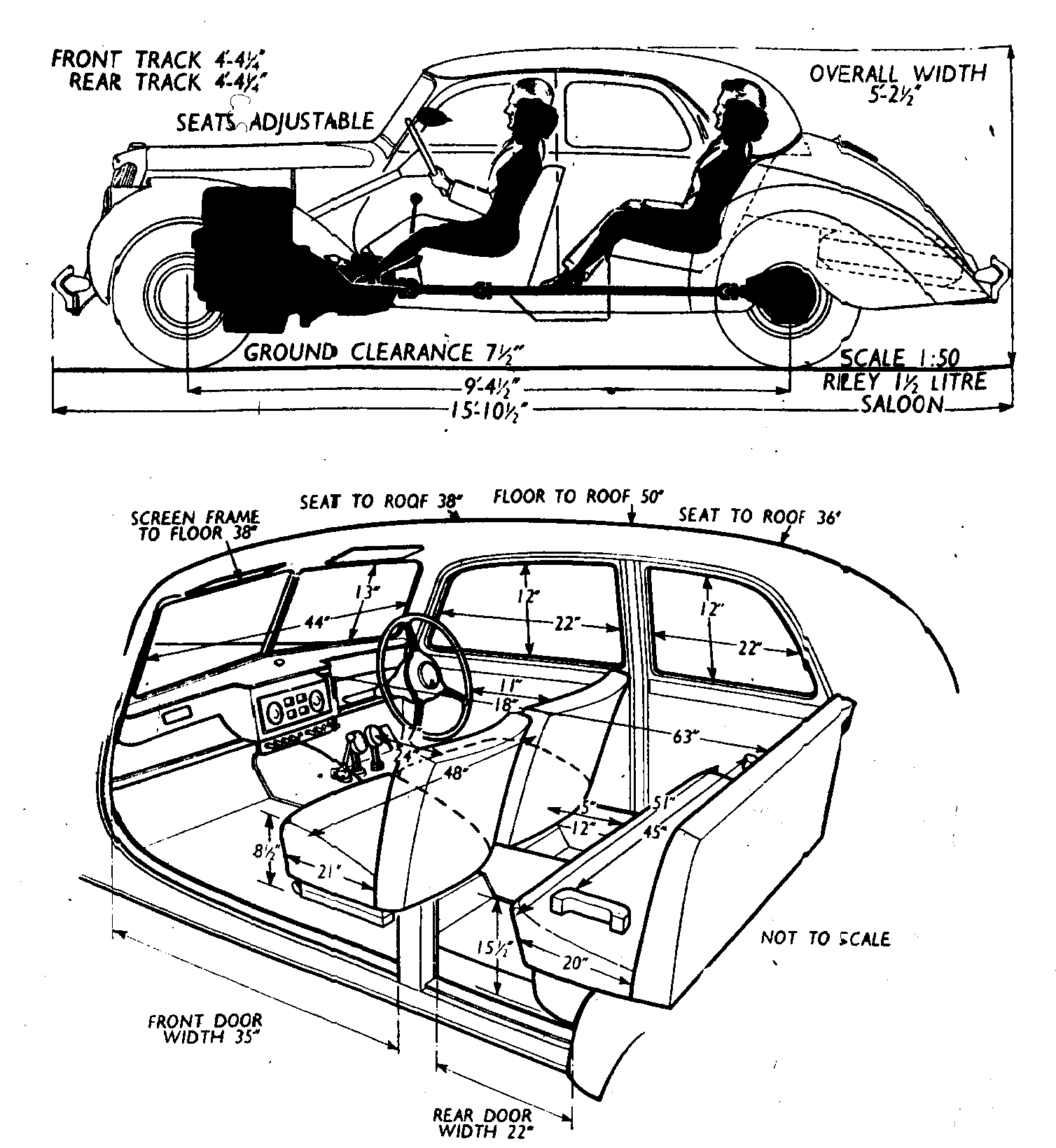
The body dimensions of the 1954 1½ RME